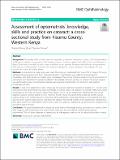| dc.description.abstract | Background: The quality of life can be impacted negatively by blindness arising from cataract. The total prevalence
of blindness in Kenya is estimated at 0.7%, however cataract contributes almost half (43%) of the total blindness in
Kenya. Optometrists are well placed to assess and refer cataract patients. However, little is known on optometrists’
skills, practice and knowledge. Therefore, this study was designed to assess optometrists’ knowledge, skill and
practice on cataract in Kisumu, Kenya.
Methods: A cross-sectional study design was used. The study was conducted from June 2019 to August 219 using
self-administered questionnaire. Basic socio-demographic characteristics were collected and participants’
knowledge, skills and practice on cataract were investigated. The primary outcome measure was the proportions of
participants who identified the questions related to knowledge, skills and practice on cataract. Chi-square analysis
was performed to assess the association between demographic characteristics of participants with practice,
knowledge and skills.
Results: A total of 49 optometrists with a mean age of 30.4 years and mean duration of practice of 1–10 years were
interviewed. Most optometrists had good knowledge on various aspects of cataract. For example (98%) had a good
knowledge on the types of cataract. Almost three quarter (75.5%) of the optometrists reported that they could
diagnose cataract correctly based on skills. However, half (57.1%) of the optometrists could not identify nuclear
cataract. Being a self reported practice and not an observed practice, most optometrists (61.2%) reported that they
did not screen patients aged 40 years and above for cataract. Almost half (52.6%) of the optometrists reported that
they did a routine eye examination however, they could not justify the significance of examining the crystalline lens
for patient above 40 years.
Conclusion: The study established that despite the good level of knowledge among optometrist on cataract, there
exist a gap on skills and practice. The results of this study calls for more clinical based activities among
optometrists. This will eases diagnosis of cataract and its management with an aim to reduce the burden in Kenya | en_US |

